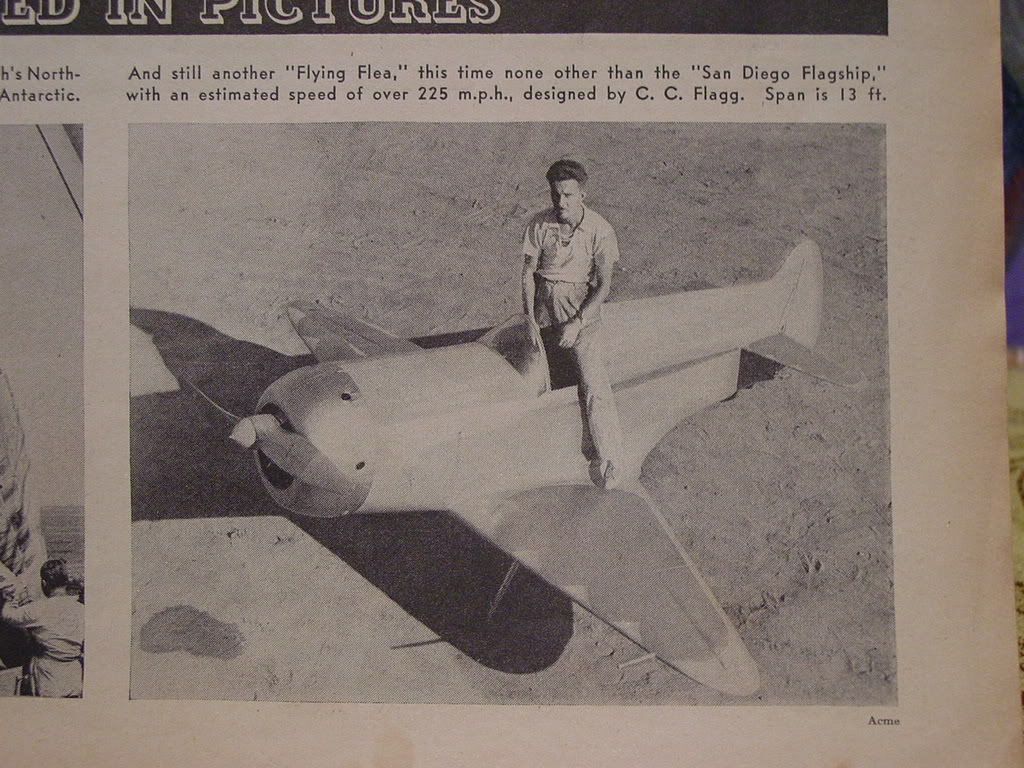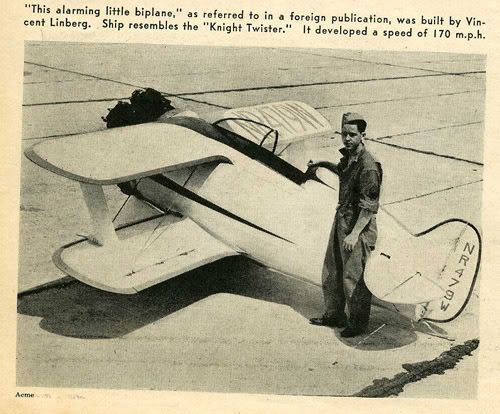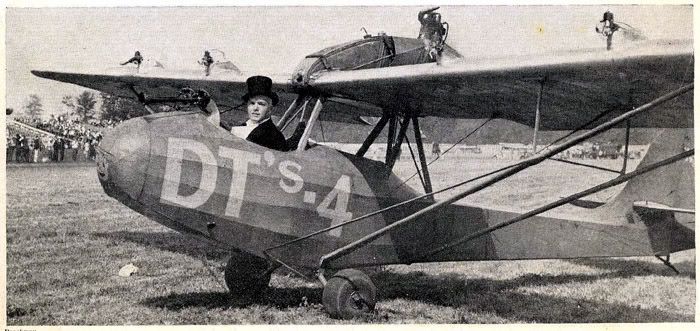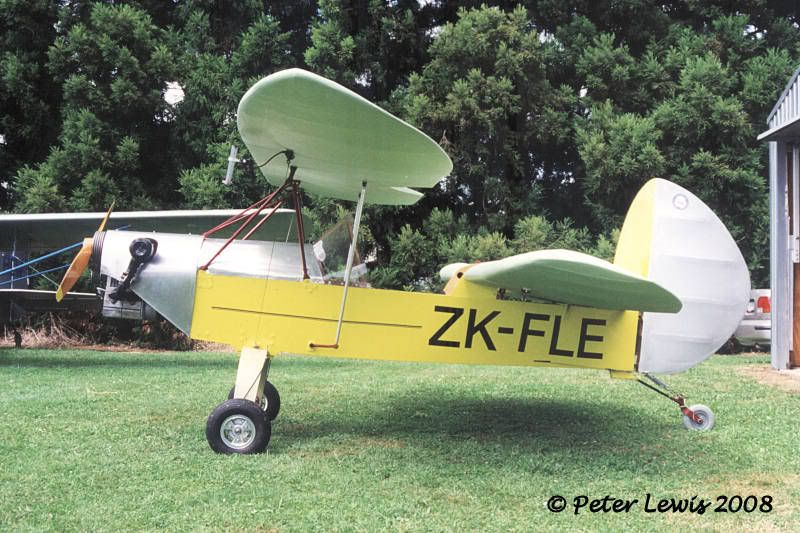|
|
Post by Dave Homewood on Jul 13, 2008 16:08:27 GMT 12
I have been loaned some very interesing old magazines and this photo come from an American pulication called 'Air Travels' dated December 1938. I just love it, I want one.  |
|
|
|
Post by Bruce on Jul 13, 2008 17:30:45 GMT 12
very cool little aeroplane.
I would guess its probably got a little Pobjoy Radial in the nose - the prop is offset above the centre of the engine. hard to tell for certain but it looks like retractable gear as well. You could quite easily buil a similar machine today using one of the new Rotec radials from Australia (90hp). Looks like wooden construction. Would easily fit into modern microlight category.
|
|
|
|
Post by Dave Homewood on Jul 13, 2008 17:51:40 GMT 12
Where do you put the two C-size batteries in though?
|
|
|
|
Post by Brett on Jul 13, 2008 17:55:39 GMT 12
They probably picked the best angle to photograph it from. The side view makes it look a little dumpy. aerofiles.com/flagg-f15.jpgBuilt By Claude C Flagg, it was powered by a 90hp Pobjoy Niagra. It was flown by Tony LeVier, who went on to became a Lockheed test pilot and P-38 race pilot. |
|
|
|
Post by sleemanj on Jul 13, 2008 17:56:15 GMT 12
Looks rather Geebee-ish, and I suspect rather unstable in flight.
|
|
|
|
Post by Dave Homewood on Jul 13, 2008 18:10:28 GMT 12
Ooh, yes, side on it is a little ugly.
|
|
|
|
Post by FlyingKiwi on Jul 13, 2008 20:47:17 GMT 12
I imagine 225mph in that would be plenty exciting!
|
|
|
|
Post by flyjoe180 on Jul 14, 2008 10:31:43 GMT 12
Looks like a mini LaGG.
|
|
|
|
Post by Dave Homewood on Jul 14, 2008 11:57:52 GMT 12
From the same photospread, there's also this little beauty  |
|
|
|
Post by Dave Homewood on Jul 14, 2008 12:06:06 GMT 12
And, um, oh dear...  It had to be French, a Simca at Le Bourget. Below is a five-engined DT's-4 flown by silk-hatted Dick Granere. Apparently it was "one of the most exciting and expertly flown acts at this year's air races". He must have been the US answer to Terry-Thomas.  |
|
|
|
Post by flyjoe180 on Jul 14, 2008 12:07:08 GMT 12
10 out of 10 for dress  |
|
|
|
Post by sniff on Jul 14, 2008 12:50:46 GMT 12
|
|
|
|
Post by sniff on Jul 14, 2008 12:52:28 GMT 12
Yeah, the sort of dress that you wear and then end up getting the DT's
Champers, anyone?
;D
|
|
|
|
Post by sniff on Jul 14, 2008 12:54:55 GMT 12
Vive la difference....  |
|
|
|
Post by stu on Jul 14, 2008 13:00:06 GMT 12
Obviously a fake .... the Flea is airborne !!! ;D |
|
|
|
Post by sleemanj on Jul 14, 2008 13:35:36 GMT 12
Obviously a fake .... the Flea is airborne !!! As I recall there were a number of fleas built in NZ. They got airborne OK, it was the keeping them airborne was the interesting bit, due to a few factors, not the least of which was most the pilots were probably self taught ;-) There was a design flaw which caused the aircraft to be able to enter an unrecoverable dive, even a shallow one, because of a bad interaction between the fore and aft wings (and the unusual pitch control method of pivoting the entire forward wing). I believe the issue was resolved in later redesigns. |
|
|
|
Post by Peter Lewis on Jul 15, 2008 22:00:23 GMT 12
I have a copy of Mignet's book "The Flying Flea How to Build and Fly It". Recommended, excellent reading. Even after all these years, his enthusiasm comes through. I understand that the irrecoverable dive tendencies of the original Flea was exaggerated by the tendency of home constructors to fit more powerful engines than originally specified to their creations - which is why Mignet himself never had this problem. I have tracked down details of seven Fleas that were built and flown in the 1930s in New Zealand: ZM-AAA by E Roy Perkins & Leonard Hawke, Waipukerau - now at MoTAT ZM-AAB by Richard D Downey & Allan McGruer, Auckland - burnt 1950 ZM-AAC by William L Notman, Oamaru - now at Wanaka unreg by Owen & Arthur Jackson (Christchurch? - Cr Fairview, near Timaru, 28Sep42 unreg by Brian & Ian McMillan, Stratford - now at Taranaki Transport Aviation & Marine Museum unreg by Cyril Aitken, Marton - fate untraced unreg by Angus Denize, Waikawau Bay - built 1930s, Cr on first test flight Waikawau Bay beach summer of 1947 Plus of course the latter day ZK-FLE/2 HM-16 by Robert J Germon, Ngatea - now with Russell Brodie at Rangitata Island. Waharoa 2002:  |
|
|
|
Post by Dave Homewood on Jul 15, 2008 23:33:51 GMT 12
It is rather surprising to read of an unregistered civil aircraft flying in NZ airspace in 1942. Most civil flying was stopped during the war. Was that flight unlawful (apart from being unregistered?)
|
|
|
|
Post by Dave Homewood on Jul 16, 2008 1:36:24 GMT 12
Peter, I just came acrossths by chance in an August 1994 article on John Neave in Wings. It says:
"John Neave's test flying skills were called upon at intervals during his stay of several years with the aero club. Barney Owen's Flying Flea, modified to become a synchroplane with both wings moving, was one that many would-be pilots tried to get airborne. John beat them all by just managing to get it off the flats at Lake Ellesmere, but he recalls it as being a "funny thing - you wouldn't have wanted to get too high above the ground."
I guess that might be of interest to you?
|
|
|
|
Post by stu on Jul 16, 2008 11:04:40 GMT 12
There is a very descriptive chapter about the Flea in the book "The Dangerous Skies" by Air Commodore A. E. Clouston.
His recollection of the first British Flying Flea display in a large field near Southend in 1936 conjures up a mental image something akin to a comedy routine. Those that have the book please bear with me while I quote from it for those who don't ....
"We arrived early but the police were already having difficulty in controlling the crowd. Fleas in various stages of construction were being dragged behind motor-cars, and even motor-cycles. Others came on trucks. Out of the dozens that were turning up, only one Flea, in the hands of an expert, flew down to the display.
I parked the Aeronca away from the crowds and we went to see the fun. The Fleas were being parked in a long line on one side of the field so that the public would have an opportunity of viewing the makers' efforts. One enthusiast with a commercial turn of mind offered all comers the opportunity to fly his Flea for a fee of five shillings for ten minutes. Fanny and I looked at one another, but when we inspected the Flea closely we saw that the owner had sawn two inches off each propeller-tip to prevent it from taking the air. Small boys, however, readily paid their five bob, and the Flea was in constant use, racing across the field in every direction. At least they got the thrill of travelling with the seats of their pants almost scraping the ground at thirty-five miles per hour. If they were lucky enough to to hit a bump, they were tossed a couple of feet into the air for fifty yards or so.
The pilot who had flown down in his Flea took off on time on the programme to demonstrate its flying qualities. When he had finished his show, other Flea owners tried to emulate him. Most had not been inside an aeroplane in their lives.
It was not long before the field was a mass of darting, screaming Fleas trying to get airborne. There was no organisation, control, or wind indicator. Each would-be flyer ignored, or was ignorant of, the wind factor, with the result that Fleas were raced across the field in any direction their owners fancied. Fleas crossed crossed on another's paths, missing one another by inches. It was only a matter of time before the inevitable collisions occurred. Fortunately, the damage was restricted to the Fleas, and no one was badly hurt.
Out of all the attempts, only one Flea at last succeeded in getting airborne. It was flown by a fifteen-year-old boy, and we discovered it was the five bob "pilot yourself" Flea with the sawn-off propeller tips which was not supposed to fly. The lad had run the full length of the field and just as he was about to crash into the hedge, he hit a bump, pulled back the stick, and found himself stuck fifteen feet up an old oak-tree. He recieved the loudest applause of the day as he was helped down from the tree.
This, however, was not enough entertainment to satisfy the spectators who had paid their half-crowns, and several thousand car-horns began to register indignation. The promoter of the display came over to Adams and myself, and, pushing five pounds into my hand, asked me to do some stunt flying in my Aeronca. For ten minutes I did some aerobatics and then landed.
The crowd waited a while, and then once again the the horns started hooting. The Flea display promoter was running round frantically looking for substitute turns. We saw him approach a pilot who had arrived in a powered glider, a motor-cycle engine rigged on top of the glider with a pusher propeller known as a drone. It was a hot day and the pilot overchoked his engine in starting. Petrol ran down the fuselage to the tail, the engine backfired, and the whole shooting match went up in flames. The crowd were delighted.
Another pilot, who arrived by autogyro to see this display was called upon to perform. He revved up the rotor blades, the autogyro jumped a few feet into the air, and then toppled over sideways to crash on the ground. The blades continued to race round, cutting out large clods of earth and slinging them all over the crowd."
|
|

